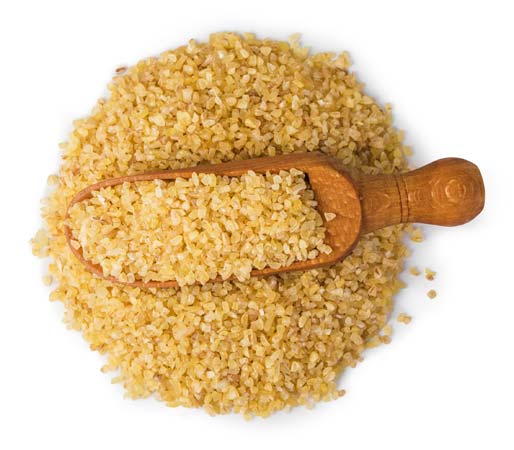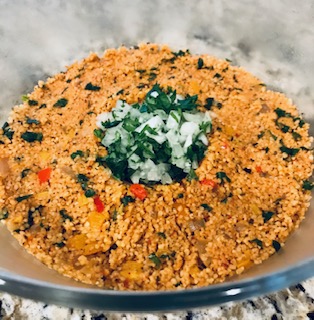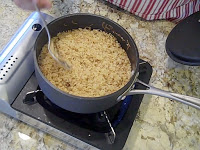Bulgur might have been the original ready-made meal in a box, if boxes were as old as bulgur.
Instead, it was the original ready-made meal wrapped in a kerchief or packed into a saddle pouch, the most reliable way to fill the belly along the loneliest stretches of the Silk Road.
Bulgur (or bulghur) is made from wheat kernels that have been steamed, dried and crushed. It needs nothing but water to transform itself from something that looks like coarse sand into a chewy yet tender cereal.
It’s remarkably filling, and loaded with all the good stuff you expect from whole grain. Best of all, you can keep on loading. Add noodles for a rice-less pilaf, add meat for a truly hearty meal. Or steam in your favorite veggies.
Bulgur absorbs flavors brilliantly, whether you stir in tomatoes, onions, or butter — or substitute your favorite stock for water.
Bulgur generally comes in three sizes, fine (#1) for kufta (Armenian stuffed meatballs) and in soup; medium (#2) for tabbouleh and pilaf; and coarse (#3) for pilaf and in stuffing. A fourth size is sometimes available, and it is larger still.
All the Armenian cooks I know have their own bulgur size preference, as I have mine. I mostly use #1 and #2. No one has complained yet.
Experiment with the various bulgur sizes to see which works best in your preparations.
Buying Bulgur:
The most obvious place to buy bulgur is in a Middle Eastern grocery store. There you’ll find a plentiful supply of all the sizes with the lowest prices. If you don’t live near one, look in a health food store. They usually have pre-packed bulgur in a few sizes, at a higher price.
Chain grocery stores don’t generally stock plain bulgur. However, I have seen pre-packaged mixes for tabbouleh with the bulgur grain included with a seasoning mix. (Try to avoid those, unless you are truly desperate!) Whole Foods Markets carry bulgur, but be prepared to pay the price.
The Internet is another way to track down bulgur. Some Middle Eastern stores have websites where you can order online and have it delivered to your door.
Check out this post for a Sarma Gurgoud recipe (Tabbouleh) using bulgur.





My mom's tabouleh (my biased opinion is that it is the best tabouleh in the world) adds diced tomatoes and cucumbers too. The tomatoes make a world of difference!!
It sounds great! Would your mom be willing to share her recipe with The Armenian Kitchen?
If so, please send it to: robyn@thearmeniankitchen.com, and I can post it.
Thanks!
Sorry but tabouleh is not an arminien food, it's libanaise..
libanaise????? i think it is spelled lebanese, and tabbouleh is actually an armenian food as well as assyrian!!! please get your facts straight, and learn how to spell what you are!
Libanaise is lebanese in French. And yes, tabbouleh is a Lebanese dish… I am a Lebanese Armenian.
Dear all, please note that this food is called ITCH and its Armenian.However because it's ingredients are similar to those of Tabbouleh's, some call it Armenian Tabbouleh.Tabbouleh is 100% Lebanese. I'm Lebanese Armenian.
Well also note that there are two ways of cooking ITCH.The first is fresh ITCH where all the ingredients are raw and the other is cooked ITCH as mentioned here.
Many recipes from the people of the entire middle east area were/are shared, adapted and changed by families and villages depending on what was available and each family's taste. If you are Lebanese Armenian you know that there are similarities in Persian, Turkish, Asyrian, Egyptian and even Greek food. We all had grapes and their leaves,lamb, wheat and other staples common to the area. Don't even get me started on Kabob, that Lebonese call Gyros and others call Shawarma, which is now common in Australia and a popular Brazilian street food!
My family's Tabouleh has Armenian cucumber and lots of fresh tomatoes, no paste, and a green bell pepper. It's the way my Grandmother, born in Armenia in 1914 taught me to make it.
Thank you for this wonderful website – very inspiring. Wonderful! God Bless you for keeping the culture alive.
I used the name "tabbouleh" here simply because many people recognize it. In fact, I grew up only knowing this dish as 'sarma gurgood', the name listed in parentheses. It was a specialty of the folks from Musa Dagh (Musa Ler), the birthplace of my maternal grandparents.
Many armenians tend to distort facts and claim dishes as their national food. First off, half of your foods are either arabic or greek descent, mainly brought to you by the Ottoman Turkish empire. I am sorry, speaking as a lebanese, the majority of eastern middle-eastern food is in fact Turkish. While we cannot find the specifics for most, the fact that the Turks controlled the whole area for almost a millenium, made the food mix and have multiple similarities. BUT, the common denominator, is that the vast majority of lebanese food is actually found in most levantine arabic countries. Hence forth establishing multiple arabic traits. Armenians either got the recipes from the Turkish influence, or from the post-genocide diaspora INTO arabic land. As you can see, most arab armenians know for a fact that these are either lebanese, syrian, egyptian foods.
I will not contest the validity of basterma being arabic. But foods like hoummos, tabbouleh, fattoush, shawarma, coussa me7shi, kafta, baba ghanouj, feuille de vigne, kafta na3e (che kefte), chich barak (monte).. are arabic in nature. PLUS, the majority of these root names are either ARABIC or TURKISH. Armenians either use their own name for it, or mostly use turkish names for them.
Now on to the LAHMAJOUN, which is actually a distorted word for the LAHME BIL AJINE, is LEBANESE. It literally means in arabic, meat in dough bread. The joun part of the armenian version just means that the meat is MAJJOUNED (pressed) into the bread. Furthermore, many, and I mean ALOT, of armenian friends of mine from Lebanon and Syria have argued with me, and when they came back from their trips to Armenia, they all said that they were wrong. That the version there, if found, is at all the same as advertised by armenians around the world. Unless you are hayastansi, or just in a closed off armenian community, you will not know the reality of the foods you are marketing as your own.
I am 4th generation lebanese, my grandfather was from the mountains of Lebanon and was born under turkish rule. If he was alive today, he would be 140 years old. We have actually recipes from my great-great grandparents of traditional lebanese-syrian dishes that have been passed on. So please, armenians, remember, you lived in our countries for a century, not us in yours.
Whew! Such vitriol. It's *food* — it's supposed to be fun!
It is good to learn and yes there are many nationalities represented in our foods here and we all will recognize our own or those of others. Our neighbors are Muslims and they too use some of the names mentioned here for various foods. This is a wonderful site to learn and enjoy thank you to all who contribute here <3
Robin I now make my tabouleh with Kale. I chop the leaves, use a handful of parsley chopped, scallions (I only use 4 or 5 thin green onions),diced tomato, diced cucumber, FRESH mint, tomato paste, salt, pepper, oil, fresh lemon juice (I sometimes add a little of citric acid). Very healthy (vitamin K) please try it. But be sure to mix everything and refrigerate at least a good hour. Of course do not forget the bulgur lol. . . sandy
we take ourselves too seriously .. relax .. if you like the recipe, use it .. if not, move on.
<3
Just made the anonymous recipe with Kale. Outstanding.